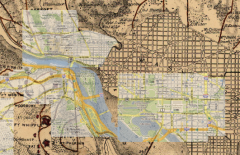Thanks to our reader Arthi for letting us know about her set of historical maps overlaid with current Google maps. A couple months back, we found the awesome 1851 and 1861 overlays that let us see how roads in the city have changed over time, and now Arthi’s maps go out even further to Annandale and Springfield. It’s cool to see how roads like Backlick Road and Arlington Boulevard haven’t moved since 1865 or how Bailey’s Crossroads was actually a major crossroads, but the Beltway and Interstate 66 seem to have been plopped down in the middle of nowhere.

I can’t help myself – it’s a pet peeve: It’s Interstate 66, not Route 66. Route 66 in common usage refers to the historic U.S. Highway 66 running from roughly Chicago to LA, built prior to the Eisenhower Interstate System. Interstate 66 was actually placed (for the most part) along a former railroad ROW (the Washington, Arlington & Falls Church Electric Railway, if I remember correctly). I believe the Beltway was a bit more random. Also, random fact, Ballston is a reference to the historic Ball’s Cross Roads – the intersection of Glebe and Wilson.
That said – Good find – it’s a challenge to correctly geogreference historic maps, especially to the modified Mercator projection that Google uses. It would be fascinating to digitize the road and rail network from each of these maps and place it into a time-series cartographic product and/or calculate alfa & beta indexes for each network or look at measures of clustering and dispersion (Moran’s I, Anselin’s Implementation of Moran’s I) for the network nodes over time.
Thanks for the correction. I’ve changed it in the post.
Pingback: Historic DC Maps | City Block